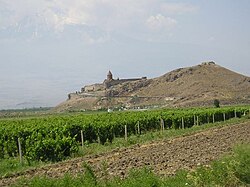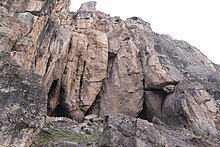Armenian wine
| Wine region | |
 | |
| Country | Armenia |
|---|---|
| Sub-regions | Armavir Province Ararat Province Vayots Dzor |
| Growing season | Cold snowy winters Warm, dry, sunny summers |
| Climate region | Continental |
| Heat units | Region III, IV, V |
| Precipitation (annual average) | 400mm-600 mm |
| Soil conditions | Volcanic soil |
| Total area | 29,800 km2 (12,000 sq mi) |
| Size of planted vineyards | 1,459 km2 (1,000 sq mi) Ranked 11th |
| Varietals produced | Vitis vinifera, Pinot noir, Rkatsiteli, Pinot blanc, Aligoté, Madrasa (grape) |
Armenian wine is wine made in the Republic of Armenia, in the region of South Caucasus. Armenia is one of the oldest wine producing regions of the world.
History


Since ancient days Armenia was famous for the wine makers where original traditions were kept until this day. It is possible to learn about this even from works of such philosophers, as Herodotus and Strabo. In 401-400 BC, when the Greek armies led by Xenophon "were passed" on the country Nairi (one of the most ancient names of Armenia), in the Armenian houses they were treated with wine and beer which was kept in deep dugouts in special "karases". It's interesting, that in karases with beer have been inserted reeds which served for our ancestors as saltcellars. Archaeological excavations carried out by academic Pyatrovski in the 19th and 20th centuries have confirmed that in the 9th century BC, Armenia was a wine-making state. Archaeologists have found, in the fortress Teyshebaini, a wine storehouse with 480 karases (clay pots), which hold 37 thousand decalitres of wine. During excavation in Karmir Blur (one of the most ancient settlements of Armenia where first attributes of life are found out a little thousand years ago) and Erebuni (city-fortress in territory of present Yerevan, build 2800 years ago and become in 2700 the capital of Armenia) had been found 10 wine storehouses in which were 200 karases. Still ancestors of Armenians - inhabitants of one of the most ancient states of the world - Urartu, were engaged in wine growing. In historian certificates, that in thus one of the most ancient states in the world the special attention was given development of wine growing and fruit growing were kept. Often in the historical data which have reached to us manufacturing techniques of wine and beer are mentioned. During Soviet Union period the Armenian wine makers were on peak of the glory.
From 1940 to 1985, manufacturing of wine increased by nine times, brandy by seventeen times, and from 1960 to 1986, the production of sparkling wines increased by a factor of ten. In the 1980s Armenia annually processed an average of about 210 thousand tons of grapes from which received 14-15 million decalitres of wine. Two million from them were used in manufacturing of brandy; the remaining part was used for wine making. 37, 4% of incomes of Armenia in the field of foodstuffs were necessary for winemaking. In 1980s Armenia provided 25% of brandy made in all Soviet Union, 3% of wines (5-6% of strong wines) were necessary on a share of Armenia. Three quarters of released production was exported mainly to Russia. During that period the Armenian wine making has been concentrated in "Ararat-trest". Having visited here, Maxim Gorky has told that it is easier to rise on mountain Ararat, than to leave storehouses "Ararat-trest". Here, in the cut gorge, there is a museum of wine making in which collection is registered more than three thousand versions of wines, aged few centuries. There are only three similar storehouses of wines in all over the world - in France, Italy and Armenia. It is impossible to miss that fact, that today many peasants, as well as three millenniums ago, process grapes and receive wine in special premises. In wine factories the material for wine is stored in oak barrels, but in many villages kind traditions of fathers to now are used, and karases are used for storage of materials of wine. Owing to its pinkish structure, Armenian oak allows receiving wines with natural taste of vanilla, chocolate and dried fruits. Wines from local Armenian grades of grapes adjoining to the surface of the barrels from the Armenian oak, give rise to unique bouquet. This unique combination is impossible to reproduce in any other country of the world.[1]

The fertile valleys of the South Caucasus, which Armenia straddles, are believed by many archaeologists to be the source of the world's first cultivated grapevines and neolithic wine production, over 6000 years ago. Although not a large player in the world of wine today[citation needed], Armenian wine played an important role in the history of wine[citation needed], and it has been suggested that the domestication of the Eurasian grape first occurred in the mountainous regions of Armenia before moving to the south.[2] During all this time they never stopped making wine. They were one of the main wine producers in the Soviet Union and have since started exporting their wine worldwide. Armenian wine even spread to Africa. During the Armenian genocide perpetrated by the Ottoman Empire during World War I, some Armenians fled to Ethiopia, where they cultivated vineyards. Many Armenian reds are very sweet and rich, and Ethiopian wine has a similar quality.[3] During periods of Islamic rule, Armenians were the suppliers of alcoholic beverages, such as wine, to the Muslims, who were not allowed distill alcohol.

In 2011 archaeologists in Armenia announced the discovery of the world's oldest-known wine production facility. Located in the Areni cave complex, it consisted of a shallow basin to press grapes, a vat for storage, and fermentation jars. They also found grape seeds, remains of pressed grapes, and dozens of dried vines. The seeds were from Vitis vinifera vinifera a grape still used to make wine.[4] The cave remains date to about 6000 BC - 900 years before the earliest comparable wine remains, found in Egyptian tombs.[5]
This is what CNN wrote:
- Forget France. It turns out, the real birthplace of wine may be in a cave in Armenia.
An international research team says it has found the world's oldest winery in a paper published Tuesday in the peer-reviewed Journal of Archaeological Science.
Earliest Known Winery Found in Armenian Cave: James Owen from National Geographic News quotes archaeologist Gregory Areshian of the University of California, Los Angeles: "The site gives us a new insight into the earliest phase of horticulture—how they grew the first orchards and vineyards"
"It's the oldest proven case of documented and dedicated wine production, stretching back the horizons of this important development by thousands of years," said Gregory Areshian, co-director of the excavation and assistant director of the University of California Los Angeles's Cotsen Institute of Archaeology.[6]
References
- ^ http://winar.am/en/about/armenia.htm
- ^ Randolph E. Schmid, "Researchers Find Oldest Known Winery In Cave In Armenian Mountains", The Associated Press, January 10, 2011.
- ^ http://www.gadling.com/2011/01/12/archaeologists-discover-worlds-oldest-wine-press-in-armenia/
- ^ http://online.wsj.com/article/SB10001424052748704458204576074141252276326.html?mod=googlenews_wsj
- ^ http://news.am/eng/news/44129.html
- ^ http://articles.cnn.com/2011-01-12/living/oldest.winery_1_wine-production-uncorking-grape?_s=PM:LIVING
